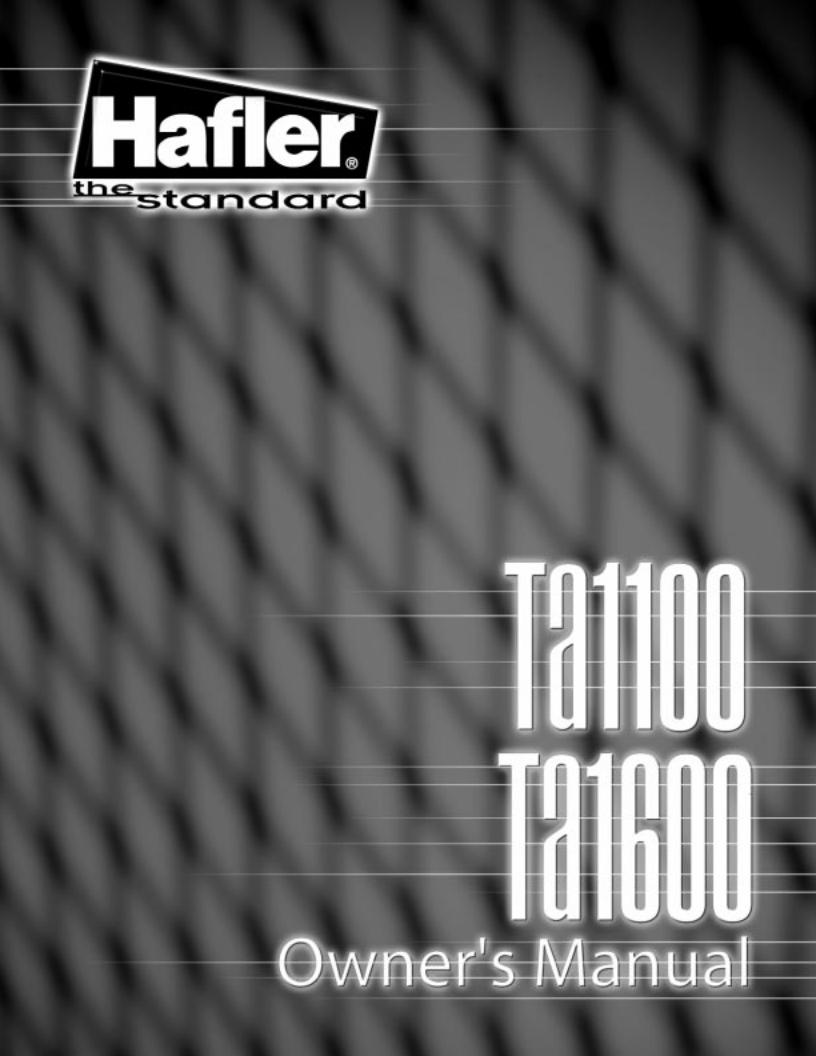Hafler 1600, TA1100 User Manual


Specifications
below rated output “A” weighted at 1kHz
per phase balanced unbalanced maximum
(to 1kHz); 150 (to 10kHz); 18 (to 100kHz) Panel: Power Switch and Level Controls Lamp, Clip/Thermal/Protect LEDs Balanced: 1/4” Tip Ring Sleeve
RCA
1/4” Phone, Spring Clip
1/4”
IEC 320
x 8 1/2”D x 3 1/2”H (2 rack space) x 25cm x 8.9cm)
0.1% THD
into 4Ω
into 8Ω
Response: |
± 0.1dB, 20Hz to 20kHz |
3dB, 1.0Hz to 100kHz
µs
power:
0.640V RMS (8Ω ), 0.510V (4Ω )
0.320V (8Ω ), 0.250V (4Ω ) per phase A quiescent
0.1% THD into 4Ω into 8Ω
1dB, 20Hz to 20kHz 3dB, 1.0Hz to 300kHz
µs
power:
0.780V RMS (8Ω ), 0.620V (4Ω ) 0.390V (8Ω ), 0.310V (4Ω ) per phase
A quiescent
– i –

NOTICE - IMPORTANT SAFETY INFORMATION
C A U T I O N
RISK OF ELECTRIC SHOCK |
! |
DO NOT OPEN |
WARNING: TO PREVENT FIRE OR SHOCK HAZARD DO NOT EXPOSE THIS EQUIPMENT TO RAIN OR MOISTURE.
The lightning flash with arrowhead symbol within an equilateral triangle is intended to alert the user to the presence of uninsulated "dangerous voltage" within the product's enclosure, that may be of sufficient magnitude to constitute a risk of electric shock to persons.
The exclamation point within an equilateral triangle is intended to alert the user of the presence of important operating and maintenance (servicing) instructions in the literature accompanying the appliance.
1.Read Instructions
All the safety and operating instructions of your Hafler equipment should be read before power is applied to the equipment.
2.Retain Owner's Manual
These safety and operating instructions should be retained for future reference.
3.HEED WARNINGS
All warnings on the equipment and in the operating instructions are important and should be followed.
4.FOLLOW INSTRUCTIONS
All operating and use instructions are important and should be followed.
5.HEAT
The equipment should be kept away from areas of high temperature, i.e., heater vents, radiators, stoves/ovens, fireplaces, etc.
6.VENTILATION
The equipment should be used in an area suitable for proper ventilation. Care should be taken not to impede airflow in and around the cabinet. Do not mount on a carpeted shelf or in a sealed enclosure. Allow for proper clearance above the equipment.
7.WATER AND MOISTURE
The equipment should not be used in or around water, such as a bathtub, sink, or swimming area. Also, the equipment should not be used in areas prone to flooding, such as a basement.
8.POWER SOURCES
The equipment should be connected only to a power source of the same voltage and frequency as that listed on the rear panel above the power cord entry point.
9.POWER CORD PROTECTION
Power cords should be arranged so they do not interfere with the movement of objects in the room: people, fan blades, utility carts, etc. Also, care should be taken that the cord is not pinched or cut, and placed so it is not in danger of being pinched or cut, as in under a rug, around a tight corner, etc.
10.POWER CORD GROUNDING
The power supply cord is of a three wire grounded type, designed to reduce the risk of electric shock sustained from a live cabinet. It is assumed to be of suitable length for most uses of the equipment. The use of extension cords and power strips is discouraged unless they are of suitable rating to deliver the required total current for safe operation of all connected
equipment. Furthermore, extension cords or power strips must provide the same three wire grounded connection. It is important that the blades of the equipment’s plug be able to fully insert into the mating receptacle. Never remove the round grounding pin on the plug in an attempt to mate to a two wire ungrounded receptacle: use a grounding adapter with the grounding tab or wire suitably connected to earth ground.
11.NON-USE PERIODS
During periods of extended non-use, the power cord should be unplugged from the power source.
12.CLEANING
The equipment should be cleaned only as detailed in the operating instructions.
13.OBJECT AND LIQUID ENTRY
Care should be taken so that objects and/or liquids, such as cleaning fluids or beverages, are not spilled into the enclosure of the equipment.
14.DAMAGE REQUIRING SERVICE
Hafler equipment should be serviced by qualified service personnel when:
A.The power supply cord or plug has been damaged, or
B.Objects have fallen, or liquid has been spilled into the equipment, or
C.The equipment has been exposed to rain, or
D.The equipment does not appear to operate normally or exhibits a marked change in performance, or
E.The equipment has been dropped, or the enclosure has been damaged.
15.SERVICING
The user should not attempt to service the equipment beyond that which is described in the operating instructions. All other service should be referred to qualified service personnel.
16.CARTS AND STANDS
The equipment should be used with carts or stands only of sufficient strength and stability for the use intended.
An equipment and cart combination should be moved with care. Quick stops and starts, excessive force, and uneven sur faces.
ii

ADVERTENCIA – INFORMACION DE SEGURIDAD IMPORTANTE
P E L I G R O |
! |
|
RIESGO DE DESCARGA |
||
´ |
´ |
|
ELECTRICA NO ABRIR. |
||
|
´ |
|
PRECAUCIONS: |
|
|
Para Prevenir el incendio o la descarga electrica, no exponer este equipo a la lluvia o a la humedad
El símbolo de flecha relámpago dentro de un triángulo equilátero, es para alertar al usario de la presencia de “voltajes peligrosos” no aislados en el interior del aparato, los cuales pueden ser de suficiente magnitud para constituir un riesgo de choque eléctrico a las personas.
El símbolo de exclamación dentro de un triángulo equilátero, es para alertar al usuario de la presencia de instrucciones importantes de operación y mantenimiento (servicio) en la documentación que acompaña al equipo.
1. LEA LAS INSTRUCCIONES
Todas las instrucciones de seguidad y operación de su equipo Hafler, deben ser leídas antes de que el equipo sea conectado dléctricamente.
2. CONSERVE EL MANUAL DEL PROPIETARIO
Estas instrucciones de seguridad y operación, deben ser conservadas para futuras referencias.
3. CUADROS DE ADVERTENCIAS
Todas las advertencias en el equipo y en las instrucciones de operación, son importantes y deben ser seguidas.
4. SIGA LAS INSTRUCCIONES
Todas las instrucciones de uso y operación son importantes y deben ser seguidas.
5. CALOR
El equipo debe ser mantenido lejos de areas de alta temperatura, como por ejemplo: ventilaciones de calentadores, radiadores, estufas/hornos, hogueras, etc.
6. VENTILACION
El equip debe ser usado en áreas con ventilación adecuada. Deben er tornadas las precauciones necesarias para no impedir el flujo de aire dentro y alrededor del aparato.
7. AGUA Y HUMEDAD
El equipo no debe ser usado en el agua ó alrededor de ésta, tales como en una bañera, tanque o áreas de nado. También, el equipo no debe ser usado en áreas propensas a inundaciones, tales como en un sótano.
8. FUENTES DE PODER
El equipo debe ser conectado a una fuente de poder del mismo voltaje y frecuencia que el indicado en el panel trasero sobre el punto de entrada del cable de corriente.
9. PROTECCION DEL CABLE DE CORRIENTE
Los cables de corriente deben ser dispuestos de forma tal que no interfieran con el movimiento de objetos en la sala: personas, aspas de ventilación, carretillas, etc. También, es necesario tener cuidado de que el cable no esté punzado o cortado, y debe estar ubicado de forma tal que esto no ocurra, como podría suceder debajo de una alfombra o al pasar el cable por una esquina aguda, etc.
10. ATERRAMIENTO DEL CABLE DE CORRIENTE
El cable de corriente es del tipo aterrado de tres hilos, diseñado para reducir el riesgo de una descarga eléctrica procendent de un
iii
chasis energizado. Se asume que su longitud es suficiente para la mayoría de usos del equipo. El uso de extensiones y multienchufes no es recomendado, a menos que tengan el amperaje adecuado para poder suministrar la corrioente requerida pra la operación segura de todo el equipo conectado. Aun más, las extensiones deben proveer de la misma conección aterrada de tres hiles. Es importante que el enchufe se pueda introducir completamente en el receptáculo. Nunca remeva el pin de aterramiento en un intento por conectar el cable en un receptáculo de dos hilos no aterrado: use un adaptador de aterramiento que esté adecuadamente conectado a un punto de tierra.
11. PERIODOS SIN USO
Durante períodos prolongados sin uso del equipo, el cable de corriente debe ser desconectado de la fuente de electrixidad.
12. LIMPIEZA
El equip debe ser limpiado solo en la forma que se detalla en las instruccione opera`Å+˘ción.
13. INTRODUCCIÓN DE OBJETOS Y LIQUIDO
Deben ser tornadas precauciones con el fin de que objetos y/ó líquidos, tales como fluidos de limpieza y gaseosas, no sean derramados dentro del chassis del aparato.
14. DAÑOS QUE REQUIEREN DE SERVICIO
Los equipos Hafler deben ser llevados a servicio por personal calificado cuando:
A.El cable de corriente ó el enchufe haya sido dañado, ó
B.Objetos ó líquido hayan sido introducidos ó derramado en el equipo, ó
C.El equipo haya sido expuesto a lluvia, ó
D.El equipo aparenta no operar normalmente ó exhibe un marcado cambio en su desempeño, ó
E.El equipo se ha caído, o el chassis ha sido golpeado.
15. SERVICIO
El usuario no deberá intentar darle servicio al equipo más allá de lo que está descrito en el instructivo de operación. Todo lo demás, deberá ser referido a servicio por personal calificado.
16. CARRETILLAS Y SOPORTES
El equipo podrá ser usado con carretillas y soportes que tengan la fortaleza y estabilidad suficiente para el uso previsto.
La combinación equipo/carretilla deberá ser movida con cuidado. Rápidas paradas y arranques, excesiva fuerza y superficies imparejas, pueden causar el volcamiento del conjunto de carretilla/equipo.
